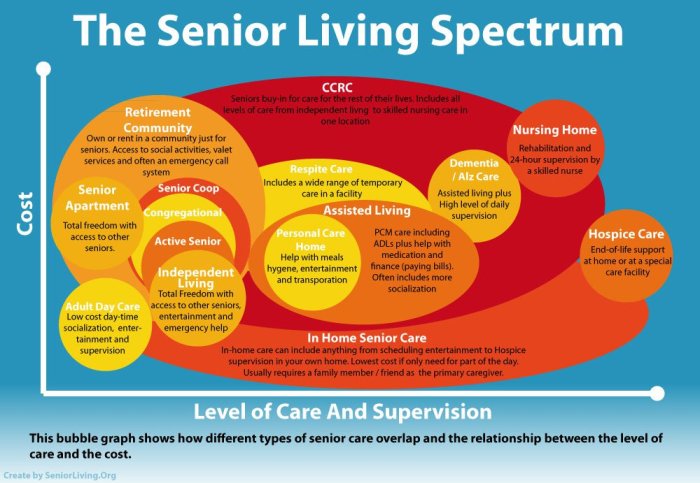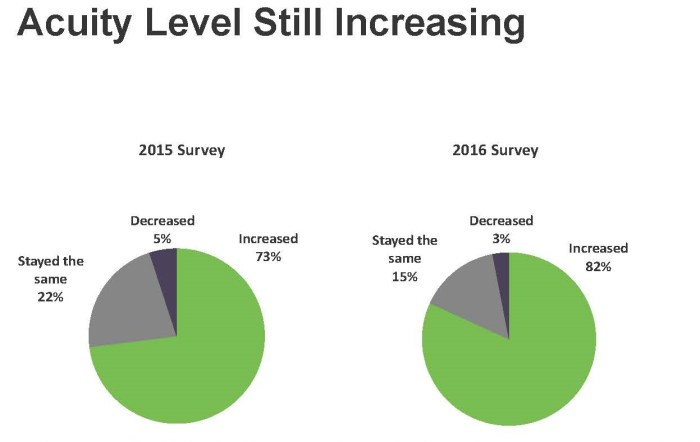Rising acuity levels in long term care facilities refers to – Rising acuity levels in long-term care facilities refer to the increasing complexity of care needs among residents. This trend poses significant challenges to staff, resources, and resident outcomes. Understanding the causes and consequences of rising acuity levels is crucial for developing effective strategies to ensure quality care in long-term care settings.
As the population ages and chronic conditions become more prevalent, the acuity levels of residents in long-term care facilities are steadily rising. This increase in acuity is driven by a combination of factors, including the growing number of elderly individuals with multiple chronic conditions, the increasing prevalence of dementia, and the declining availability of informal caregivers.
Rising Acuity Levels in Long-Term Care Facilities

Rising acuity levels in long-term care facilities refer to the increasing complexity and severity of health conditions among residents. This trend poses significant challenges to care delivery and resource allocation, impacting resident outcomes and quality of life.
Rising Acuity Levels: Definition and Causes
Acuity levels in long-term care facilities are measured by the intensity and frequency of care required by residents. Rising acuity levels indicate that residents are experiencing more complex medical conditions, such as dementia, chronic diseases, and functional impairments.
Factors contributing to rising acuity levels include:
- An aging population with increased life expectancy
- Advances in medical technology, allowing individuals with complex conditions to live longer
- Increased prevalence of chronic diseases and multimorbidity
- Shorter hospital stays, resulting in earlier discharges to long-term care facilities
Impact on Care Delivery
Rising acuity levels present challenges for staff in providing care to residents. Higher acuity residents require more intensive and specialized care, including:
- Skilled nursing care
- Medication management
- Assistance with daily activities
- Cognitive and behavioral support
Staff may experience increased workload, stress, and burnout, impacting the quality of care provided.
Implications for Staffing and Resources
Rising acuity levels have a direct correlation with staffing shortages in long-term care facilities. The demand for skilled nurses and other healthcare professionals has increased, while the supply has not kept pace.
Strategies to address staffing needs include:
- Increasing recruitment and retention efforts
- Providing specialized training and education
- Optimizing resource allocation through technology and innovative care models
Resident Outcomes and Quality of Care, Rising acuity levels in long term care facilities refers to
Rising acuity levels can affect resident outcomes and quality of life in several ways:
- Increased risk of complications and hospitalizations
- Diminished functional abilities and independence
- Reduced quality of life and well-being
It is crucial to monitor and evaluate resident outcomes to ensure appropriate care and improve quality of life.
Future Trends and Projections
Anticipated trends in acuity levels include:
- Continued increase in acuity levels as the population ages
- Growing prevalence of dementia and other chronic conditions
- Increased demand for long-term care services
These trends will have significant implications for care delivery and policy development, requiring innovative solutions and a re-evaluation of current practices.
Best Practices and Recommendations
Best practices for managing rising acuity levels include:
- Implementing interdisciplinary care teams
- Utilizing technology to enhance care delivery
- Providing staff with ongoing training and support
- Developing innovative care models to meet the changing needs of residents
By implementing these best practices, long-term care facilities can improve care delivery, enhance resident outcomes, and mitigate the challenges associated with rising acuity levels.
General Inquiries: Rising Acuity Levels In Long Term Care Facilities Refers To
What are the causes of rising acuity levels in long-term care facilities?
Rising acuity levels in long-term care facilities are primarily driven by the increasing number of elderly individuals with multiple chronic conditions, the growing prevalence of dementia, and the declining availability of informal caregivers.
What are the challenges posed by rising acuity levels?
Rising acuity levels pose significant challenges to staff, resources, and resident outcomes. Staff may struggle to provide adequate care to residents with complex needs, leading to increased workload and burnout. Facilities may also face staffing shortages and resource constraints, which can further compromise care quality.
What are the implications of rising acuity levels for resident outcomes?
Rising acuity levels can have a negative impact on resident outcomes, including increased hospitalizations, decreased quality of life, and higher mortality rates. Residents with complex needs may require more intensive care, which can be difficult to provide in long-term care settings.


